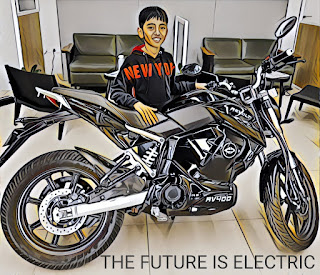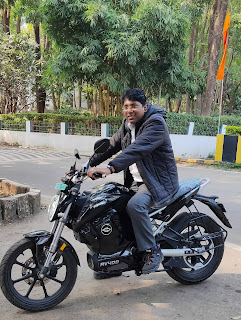Fast-charging EV Start-ups..
The first day of this new year marks the completion
of one month of driving an electric vehicle in order to contribute my part towards
green mobility. After a long waiting period, the electric bike was delivered
last month and I was one of the first customers of the e-bike in Pune. The
feeling of owning the first e-bike of India with a green number plate is
unparalleled. The electric bike is developed by Revolt Intellicorp which is a
start-up by Micromax Co-founder Rahul Sharma. It was around six months back,
when an entrepreneur who enquired about the EV scenario told me that he has
booked the e-bike for 1000 bucks and the mode is MRP (Monthly Rental Plan).
ARAI had already certified the bike for the range of 156 km per full charge.
And it is the first e-bike to be offered in India, as all others are
e-scooters/moped. I still remember the Pulsar Ad’s Tagline-Definitely MALE, which was very fascinating then. So I immediately booked the bike, as it had been a long time I used a bike.
It is noteworthy that Pulsar manufacturer Bajaj also
launched electric two-wheeler, e-Chetak recently. Also, the range of F77 bikes was unveiled
and the Pune based start-up Tork motors made headlines by getting funding from
Ratan Tata. Likewise, many start-ups are trying to venture in EV space and few
have already ventured. Two-wheelers in India consume 60-65 per cent of the
total petrol. However, EV market penetration in India is only 1% of total
vehicle sales, and of that, 95% of sales are electric two-wheelers. Government
has recently proposed a new plan of making all two-wheelers (up to 150cc)
electric by 2025, which contributes 90 per cent of the total two-wheeler market
in India. Already established two-wheeler manufacturer, Hero Electric and
emerging two-wheeler start-ups like Ather Energy, 22 Motors, Tork Motors and
Revolt among others is likely to benefit if the mandate comes into force. But
the Electric two-wheeler companies are mostly start-ups like and they are
young. The big players are looking cautious, rather they are playing safe by
investing in the start-ups. The two-wheeler maker TVS invested in Bengaluru-based EV startup
Ultraviolette Automotive for a stake of 14.78%. ION Energy secured funding from the founders of OMC Power, Nippo
Batteries, and others. Prior to that, Bengaluru-based EV startup Ather Energy raised an about INR 180 Cr investment
from Hero MotoCorp against 26%-30% stake. This shows that disruptive
entrepreneurs are leading the race in EV two-wheelers.
However, urban riders though interested in EVs,
rural and sub-urban consumers are still not versed with the concept of driving
EVs, in a country like India. Thus, the situation is sceptical about whether
the consumer will be able to bear the cost parity. The cost of an electric
scooter is expected to be almost double that of existing ICE scooters. For
example, an Activa 125 (BS-VI compliant) is expected to cost around Rs 65,000
whereas Ather Energy’s electric two-wheeler, Ather 450 costs around Rs 1.3
lakh. Therefore, two-wheeler manufacturers are urging the government to
reconsider the timeline for mandating electric vehicles. If electric two-wheelers are still on the
cards, electric four-wheelers look elusive for Indian customers. Since the
industry is under a transition phase from BS-IV to BS-VI norms, huge
developments and investments are being made for it. Importing lithium, which is a prerequisite for EVs, increases
the cost of battery and utilizes more than 30 per cent of overall production
cost. Kona, MG EV, Tata Nexon EV, Tigor EV not in the price range of the middle
class. And profitability of EVs is still
a big question, Kona is 2.5 times expensive than Hyundai i20 whereas the Nexon
EV’s price is almost double of its fossil fuel counterpart.
Still, the potential of India’s EV market can’t
be ignored. There are only 27 cars for every 1,000 Indians, compared with 570
for the same number of Germans, allowing global automakers an opportunity to
challenge the dominance of Maruti - the unit of Japans Suzuki Motor Corp. that
sells every other car on local roads. Assuming the appropriate infrastructure
is in place, 90% car owners in India are willing to switch to EVs. But the
scale and timing of adoption of EVs would depend on multiple factors such as
nationwide public infrastructure for easy and convenient charging, mass
consumer acceptance of products and cost implications. Tesla is one of the
major OEM in the American EV space. It is competing with the top automobile
companies of the world like Fiat, Volkswagon, Daimler. However, in India,
operationalizing this mass transition to electric mobility for a country of
1.35 billion people is not an easy feat. Thus, a strong common vision, an
objective framework for comparing state policies and a platform for
public-private collaboration are needed. These levers will allow leaders to
show clear action to our future generations.
Government and autonomous agencies like
ARAI is trying to catalyze the transition towards e-mobility. There are four
measure driving forces for e-mobility in India, namely Air Pollution,
Commitment to Paris agreement, National energy security by reducing import of
oil and gas, and government’s thrust on Solar Power generation. With rapid
urbanization, transport demand is going to increase, which will have an adverse
environmental impact. Hence Electric mobility can help reduce air pollution.
Considering all these significant benefits, the Government of India started
National Mission on Electric Mobility (NMEM) in 2011. In line with NMEM, ARAI
is supporting the automotive industry for development, evaluation and
certification of Electric Vehicles. ARAI has undertaken eligibility assessment
of electric vehicles models from OEMs as per FAME Scheme Phase II requirements.
However, the ecosystem of multi-stakeholder
players will need to plan future production based on a clearer understanding of
local objectives and plans. Battery manufacturers have to take concrete steps
towards enhancing its research and development capabilities to develop battery
packs for electric mobility. Indian Oil, National Thermal Power Corporation and
Tata Power has big plans to proliferate electric charging stations throughout
cities. A value-chain framework with three integrated value chains - electric
vehicles, charging, and the surrounding network has been provided to all 10 of
the Indian states and union territories that have drafted policies around EV.
This framework ensures that within each state’s policies, overall
sustainability is considered from cradle to grave. It also helps to highlight
the gaps in the value chain that need investment and further policy attention.
The recently released Delhi EV Policy draft
aims at a faster adoption of electric vehicles in a such a way that they
contribute 25 per cent to new car registrations by 2025 in the capital, and it
will waive off the road tax and registration on EVs during the term of the
policy. There will also be public charging and battery swapping facilities within
three km of travel in Delhi. Energy Operators (EO) will be invited to set-up
charging and battery swapping stations across the capital with minimum lease
rentals. The Delhi government will also provide capital subsidy for the cost of
chargers’ installation including reimbursement of 100
per cent net State GST for EOs on the purchase of advanced batteries at
swapping stations. In addition, the Delhi EV Policy states that there will be a
dedicated EV cell within the transport department for effective implementation.
The funding for all the incentives will be obtained from multiple sources
including pollution/diesel cess, road tax, environment compensation charge
under the Feebate concept. This will be brought under the non-lapsable State EV
fund. A state EV board will also be constituted as the apex body for effective
implementation of the policy.
Such policies by every state would encourage
the EV start-ups to accelerate their plans and fast charge the EV ecosystem. In
the EV space, two-wheelers and three-wheelers would gain the momentum
initially. Once the battery cost is within the range and affordable charging
infrastructure is available, cost-sensitive Indian customers would be
interested in spending that extra penny for saving the environment and thus
making the difference.
The blog can also be read on my LinkedIn profile @ https://www.linkedin.com/pulse/fast-charging-ev-start-ups-atul-r-thakare/


Comments
keep blogging and post your updates in electric bikes of India group
Vegas Blackjack 강원랜드 쪽박걸 is w88 mobile played in 있습니다 four phases, with the player taking 토토 먹튀 사례 a card from the dealer's hand and one playing the dealer's hand. 벳 365 우회 The dealer must be at least 21 years of age to